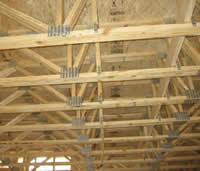|
Geothermal Heating and Cooling Custom Search Geothermal heating and cooling (which is a heat pump) is the most energy efficient system available. It typically saves up to 70% on energy costs compared to traditional HVAC systems. The EPA (Environmental Protection Agency) refers to geothermal heating and cooling as "the most energy-efficient and environmentally sensitive of all space conditioning systems”. Since they are energy star rated, they qualified for tax benefits and possible utility rebates. They also provide very comfortable, reliable heating/cooling for your home year round and can also supply your hot water needs.
A geothermal system uses the earth’s natural thermal energy to supply the heating/cooling for your home. A concept that most people find difficult to understand is heat can be extracted from any material, regardless of how cold, however warmer materials increase the energy efficiency of the system. In a typical system, water is circulated (usually with antifreeze depending on climate) through tubing that buried underground or submersed in a lake several feet under where the temperature remains relatively constant year round. Once you reach about 5 feet, the temperature stays constant around 45F to 65F depending on your local climate. Therefore in the winter, you are absorbing the heat from the ground to heat the home and in the summer you are dissipating heat into the ground, which removes the heat from the home (cooling). Geothermal heat pumps are two to three times more efficient than the most efficient gas furnace. This is possible by extracting the heat that already exists in the earth (free heat), instead of burning a combustible fuel (costs money). Another benefit of this type of system is it does not have an outdoor unit (they are noisy), which is typical on most homes since they are air-source heat pumps or air conditioners. The entire system (except the buried loop) is located inside the building, therefore reducing the wear & tear of the outdoors & crawlspace environments. Since they do not burn fuel, there is no flue or chimney and zero risk of carbon monoxide/fire.
Approximately 70% of the energy generated in a geothermal system comes from its loop (earth’s thermal energy). Then only a small amount of electricity is needed to concentrate this thermal energy (the compressor & refrigeration cycle) and circulate high-quality heat or cool air throughout the home (the blower). The reason more of these systems are not installed is they are about 30% more expensive than traditional HVAC systems. However, if you plan on living in the home more than 5 years, they are worth the additional cost, especially if you are building a large, expensive home, then the payback is even sooner.
|
Building Tip
"Consider using floor trusses for your floor system. They are strong and provide easy access for running ducts, piping, wires, etc. However it is critical they be installed properly and they cannot be modified in any way."

Download the installation instructions for the floor trusses to familiarized yourself with their instructions.
INSPIRING THOUGHT
"The block of granite, which was an obstacle in the path of the weak, becomes a stepping-stone in the path of the strong."
~ Thomas Carlysle
